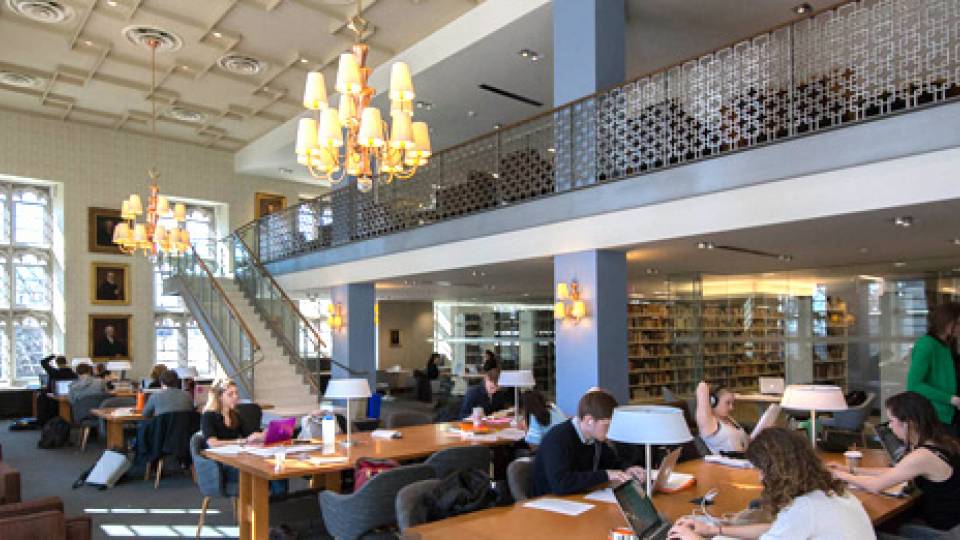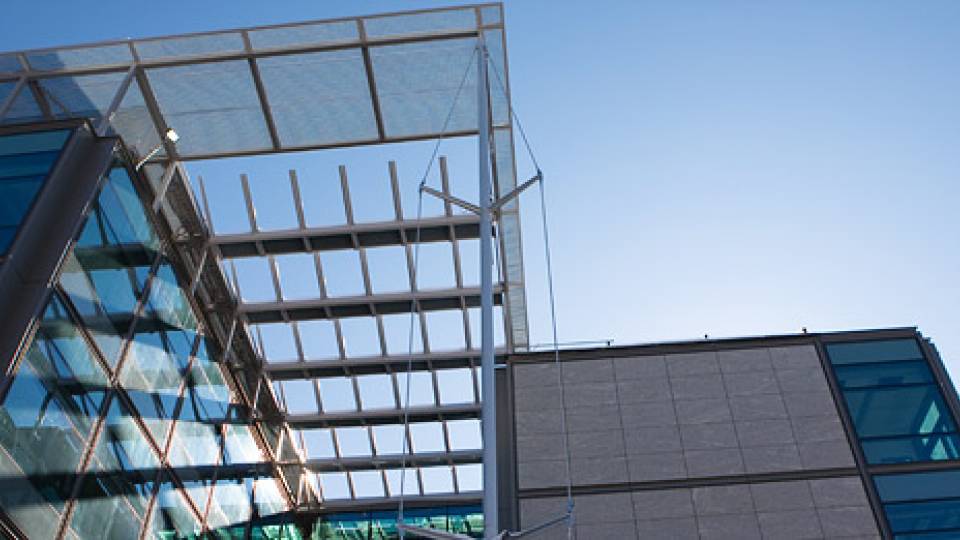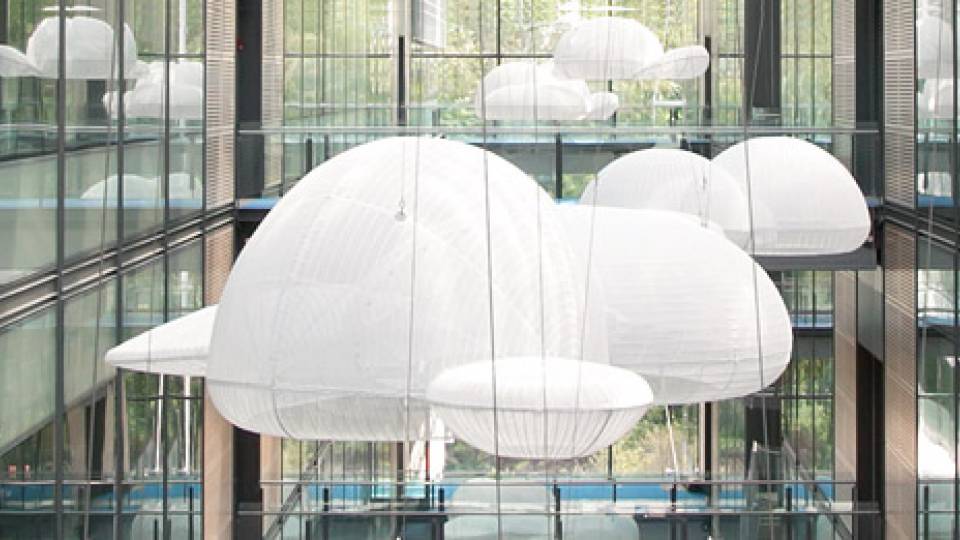Construction has begun on a major renovation of the 20 Washington Road building, aimed at centralizing economics and international programs that are spread across campus.
Built in 1929 by prominent Collegiate Gothic architect Charles Klauder for the Department of Chemistry, the structure comprises about 200,000 square feet. The renovation will transform the interior and add a welcoming connection to Scudder Plaza and Shapiro Walk to the south, while preserving the building's stone façades, arched entryways and lobby from Washington Road, and wood-paneled library, which is planned to be turned into a common room. The building has been vacant since the chemistry department moved to the new Frick Chemistry Laboratory in 2010.

As part of the 20 Washington Road renovation, a new four-story atrium (shown in this rendering) off the Washington Road entrance will primarily serve the economics-oriented academic units. (Image courtesy of KPMB Architects)
Some major elements of the renovation are a new atrium off the existing Washington Road entrance, a second atrium and second entrance from Scudder Plaza, and three rooftop pavilions overlooking Washington Road. Each atrium will feature a meeting room suspended over casual seating areas. Toronto-based Kuwabara Payne McKenna Blumberg Architects designed the project.
"When the old Frick Lab was built, the entire campus was to the west, and so that is where the entrance was located. Now the campus surrounds the entire building, and we have an opportunity to provide access and connections for all of the students, faculty and staff who work in the neighborhood," said University Architect Ron McCoy. "The signature feature of the interior renovation will be the ability of users and visitors to simultaneously experience the heritage architecture together with a vibrant, contemporary academic setting."
The anticipated completion date is summer 2016, said Lorine Murray-Mechini, senior project manager in the Office of Design and Construction.
One of the first steps was the removal of the saucer magnolia trees on the north side of Scudder Plaza, which were about 50 years old and showing signs of stress and disease, and which would not have survived being transplanted. Mature saucer magnolias will be planted in the same location as part of the landscaping for the renovation.

When the renovation is complete, 20 Washington Road will have a more welcoming connection to Scudder Plaza, Shapiro Walk and the rest of the buildings in the neighborhood, as shown in this rendering. (Image courtesy of KPMB Architects)
In the next few months, construction crews will focus on demolition within the building, as the project involves upgrading all utility systems and reconfiguring much of the layout.
Then, some portions of the exterior, including a concrete addition on the eastern façade and the bridge to Hoyt Laboratory, will be removed. Construction of the atria and pavilions will begin later this year.
The building will meet LEED Gold standards under the Leadership in Energy and Environmental Design rating system developed by the U.S. Green Building Council. Sustainability features include: adaptive use of a historically significant structure; reused materials, such as historical woodwork; sustainable materials used in building finishes; energy-efficient systems, including radiant heat panels on the ceiling, chilled beams, daylight sensors and LED lighting; exterior shading devices; low-flow plumbing; and landscape-based stormwater management.
Joining people and programs
While the building's design will be cohesive and include some shared amenities, the economics and international units will have separate entrances and spaces.
The Washington Road entrance, a four-story atrium and the west side of the building will serve a number of economics-oriented academic units — the Department of Economics, International Economics Section, Industrial Relations Section, Educational Research Section, Bendheim Center for Finance, Griswold Center for Economic Policy Studies, Julis-Rabinowitz Center for Public Policy and Finance, Research Program in Development Studies, Center for Health and Wellbeing, Behavioral Policy Center, and Center for Behavioral Science and Public Policy.

The renovated 20 Washington Road will feature a new atrium, facing Scudder Plaza, that will serve as a hub for the internationally focused tenants of the building, as shown in this rendering. (Image courtesy of KPMB Architects)
"It is hard to overestimate the value that the move will have for departmental collegiality and interactions. We have been spread across six buildings for many years now," said Gene Grossman, the Jacob Viner Professor of International Economics and chair of the economics department, also a professor of economics and international affairs in the Woodrow Wilson School of Public and International Affairs. "Although the distances are not great, it makes an enormous difference who one runs into in the corridors, the coffee room and the mailboxes. We will be able to talk more, and across a wider range of subfields of economics, about current events, research papers, departmental business and everything else. I am confident that many new papers and a more cooperative spirit will result."
The international offices will be housed on the first two floors of southeast side of the building, with a separate entrance off Scudder Plaza featuring a glass atrium and café. The Council for International Teaching and Research, Princeton Institute for International and Regional Studies, Office of International Programs, Davis International Center, Bridge Year Program, and the Princeton in Africa, Princeton in Asia and Princeton in Latin America fellowship programs will all reside at 20 Washington Road.
Diana Davies, vice provost for international initiatives, said the building's location, in a central part of campus and at the crossroads between the humanities and social sciences, sends a message about the importance of internationalization to the University. Bringing the various programs together will benefit the University as well.
"Although the level of international activities at Princeton is impressive, these activities are spread across campus, so it is hard to get a sense of the full scope and variety of our international programs, exchanges and collaborations," Davies said. "By bringing all of these offices under one roof, students, faculty, staff and visitors will have a more tangible sense of the full range of international opportunities that Princeton offers."
She added, "Although reporting lines will remain the same, the close proximity of different offices should allow for new efficiencies, as well as all kinds of collaborative innovations, including those wonderful initiatives that can come out of chance encounters between, for example, outgoing study abroad students and incoming international students; or a scholar from Vietnam and a student who is considering a Princeton in Asia placement in that country; or faculty members who are conducting cutting-edge research in the same subject area, in different parts of the world."



